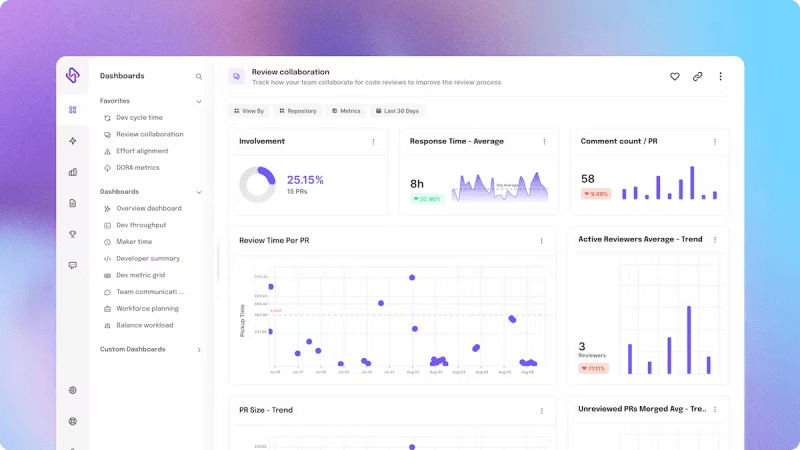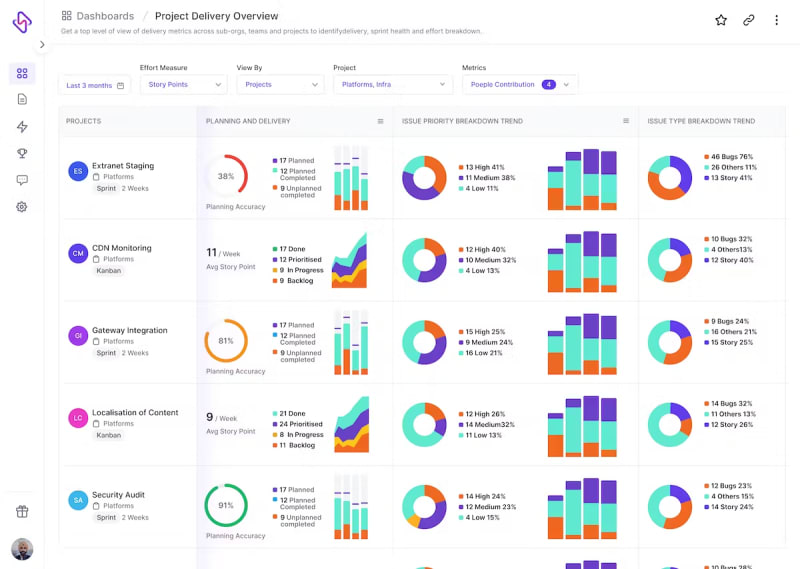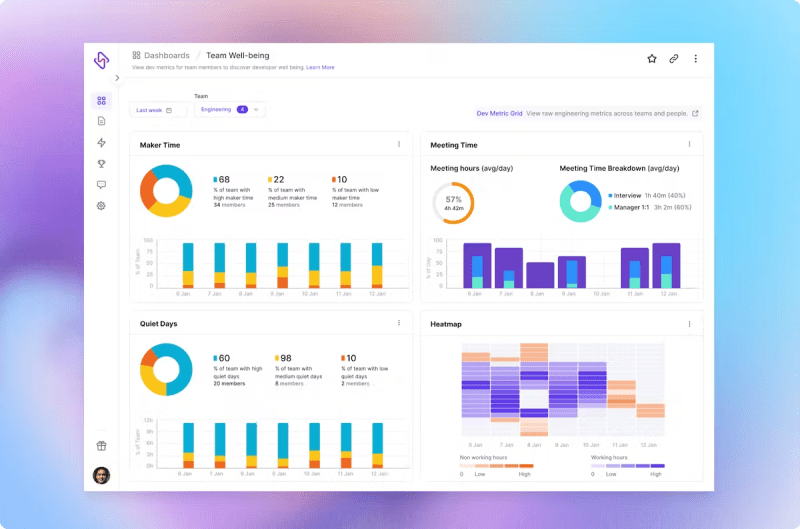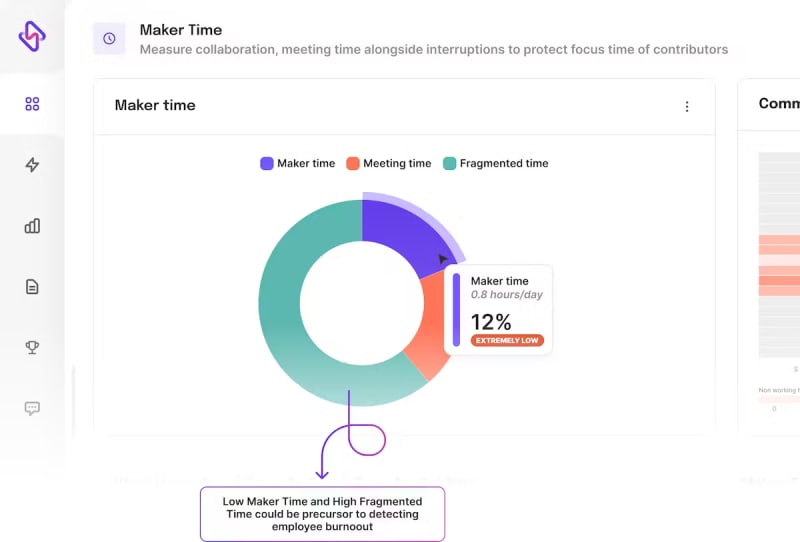A Buyer’s Guide to an Engineering Management Platform

Naomi Chopra
Posted on September 26, 2023

Just like Uncle Ben purposely told Peter- With great power comes great responsibility 🚀; global engineering leaders today find themselves facing a similar truth.
As the leadership is under constant pressure to deliver at scale, move faster, and surpass competitors; they need specific tools to strategically organize their developmental efforts. While it is easier to align Sales, and Marketing teams with business goals through Salesforce, or HubSpot; engineering teams, until recently, lack a comprehensive platform to analyze, and optimize the software pipeline.
An engineering management platform (EMP) revolutionizes the way engineering teams work, function, and deliver. It bridges the gap between business expectations, and engineering operations, uses analytics to rationalize workflows, and drives engineering success.
Engineering management platforms are a long-term, and one-time investment. However, finding the right EMP can be really chaotic, and add undue pressure on engineering leaders without the right guidance.
A Checklist For Buying Engineering Management Platform
To make it easier for engineering leaders, here’s a buyer’s guide to consider when assessing an engineering management platform:
1. End to End Workflow Visibility
As work becomes more distributed, the most tormenting question every engineering leader ever encounters is- How do we get visibility when our teams are working remotely?
Work visibility allows teams to understand developmental bottlenecks, emulate success patterns, and undergo continuous improvements. Visibility even snowballs into a high-morale team, where ICs are empowered, productive, aligned, and have enough room for product innovation.
Your choice of engineering management platform should integrate with an engineering team’s digital toolstack to collate contextual data points, and drive actionable insights out of it. Moreover, the right EMP should facilitate visibility into not just engineering operations, but also takes care of the “people” side of things.
This data-driven visibility empowers managers to celebrate their engineer’s work, allocate work fairly, and get a grasp on operational bottlenecks snowballing into failed products.
💡One hack to find the best engineering management platform for your engineering team is to ensure the flow of visibility isn’t just restricted to C-sec executives, rather it flows down to ICs as well. The data-driven dashboards, when made accessible to all employees, help bring clarity into team communication, and have more objective, and purpose-driven conversations.
2. Integration Across A Team’s Toolstack
Data cannot be an answer to engineering inefficiencies until and unless it is laden with enough context, and a single source of truth. Collating necessary insights requires your EMP to pick up team critical data across the team’s workstack. Without optimal integration with the team's workspace, an EMP cannot help create a comprehensive view of engineering operations.
In another scenario, if a team is buying an engineering management platform with limited connectors, only integrating the VCS, or the issue tracker- the driven insights will be half baked, and can harm the team more than actually empowering them. Only when engineering teams have a 360 degree view of what’s happening at each moving part of the SDLC- VCS, on-prem, issue trackers, or project trackers, they can strive for data-laden, and factual improvement. To ensure this is the case, a team’s chosen EMP must have integration capabilities across all critical team tools, without fail.
Looking for integrations that Hatica provides for your engineering team, visit here.
3. Code Hygiene
The Internet already has enough debates on what constitutes good code, and bad code. Despite so much awareness around process hygiene, not a lot of dev tools directly attack bad code, and improve it. Bad code is 30% slower than good code. It hampers the review flow, is difficult on the eyes, and can even create communication barriers between teams, while impacting the overall product quality.
Before buying an engineering management platform, engineering leaders should know- how this tool is going to improve our code quality, or help us write cleaner code?
An advanced engineering management platform comes with built-in capabilities that help teams identify, and flag large, and complex PRs. Moreover, the right EMP for your team should also track the PR review status, identifying PRs that have not been reviewed or have been waiting for an extended period, so they are not stuck or overlooked in the review process.
Code hygiene can be further improved through code collaboration metrics with additional insights into number of reviews, review duration, and review feedback. These metrics help identify bottlenecks in the review process, and ensure consistent and thorough reviews.
4. Optimize DevOps Processes
The right EMP for your team should be beyond tracking signal metrics only. Rather, it must aim to bring an efficient process management system in place. In DevOps teams, continuous delivery is the key to engineering success; however, in complex workflows, even minute process friction can falter the delivery pipeline.
For DevOps teams, the choice of EMP should cater towards improving DevOps processes, and predictability of releases. Advanced engineering management platforms combine DevOps metrics, with actionable context on testing, deployment, and operations. By tracking, analyzing, and nurturing metrics like cycle time, and mean time to recovery (MTTR), an optimal EMP creates a culture of continuous improvement, and democratized engineering success.
Moreover, another consideration that most engineering teams miss out on is proactive detection of bottlenecks as soon as they strike the delivery pipeline. Buying an engineering management platform that works in retrospect can backfire, and do more harm than good, with too many false positives, and an incomplete picture of the state of engineering.
In a nutshell, buy an engineering management platform where EMs no longer wait for Individual Contributors to highlight workflow frictions. Instead, they leverage real-time data to detect breaches in their DevOps benchmarks, empowering engineering teams to swiftly address bottlenecks, such as slower code reviews, or extensive handoffs, and devise action plans.
5. Tackling Sprint Success
Sprints are a sacred business for engineering teams. Successful sprint planning occurs at the intersection of product owner, engineering, and business teams, and strategizes the next milestones by enrolling all stakeholders.
An ideal engineering management platform must cover sprint over sprint trends, with an overview of delivery velocity. However, only keeping a bird eye view on sprints is a perfect recipe to failure. The EMP should also arm the engineering team with data-backed insights on workload allocation, sprint velocity, and priority items.
At the end, engineering managers should be able to analyze, and answer- how much unplanned work was encountered by the team, and where did most ICs spent their time: was it bugs, maintenance, or story points. The idea is to detect, and minimize unplanned work, so teams can plan better, and are better prepared to deal with emergencies.
💡With Hatica’s engineering management platform, teams have improved their planning accuracy by 30%.
Know how Hatica empowered Bobble.ai to improve project velocity by 2.2x.
6. Resource, Cost, and Effort Alignment
A new trend is to be seen in software engineering– uneven engineering demands, high software development cost, and even higher budget overruns– making all the way for frugal, and sustainable engineering. Today, only 8% of engineering teams are successful in meeting their business goals with current techstack.
Your chosen engineering management platform should robustly track resource spending, and help you to balance scales between new business priorities, and existing maintenance.
Moreover, the investments should also be segmented, and visualized vis-a-vis new features, reducing complexity, and categorizing work: bugs, feature building, technical debt, or roadmap implementation.
💡Teams have started saving upto 28x of their budget overruns after using the right engineering management platform for allocation needs.
Besides a breakdown of engineering investments, an EMP should also present a complete picture of where each engineering effort is being spent. That way, engineering managers know where their developers are blocked, and the human capital is utilized at its best.
7. Track, Optimize, and Manage Project Deliverables
Today, every software team wants to ship faster, and scale at innovation. However, most teams lose sight of what’s important- product quality, and cycle times, in pursuit of vanity metrics. Your chosen EMP should help you from falling into the trap.
The right EMP should not only track engineering activity in terms of code hygiene or sprint health, but also project deliverables at all stages, and team levels. An advanced EMP must record project milestones, realistically understand engineering performance, and keep all business teams aligned with each other. Moreover, it should empower managers to proactively deal with scope creep through early signs of dwindling key metrics like velocity, and variation metric.
An engineering management platform should be able to track project deliverables in terms of deployment, code quality, cycle time, unreviewed yet merged PRs, and code review analysis. That way, engineering teams can code faster, build on high quality code, and identify barriers that have been hidden previously.
8. Team Health and Well-Being
There has been a famous story around Gmail for years. Gmail wasn't originally part of Google's engineering roadmap, but when a forward-thinking developer was given the freedom to innovate and experiment, they conceived the idea that later revolutionized the world of electronic mail. That is the power of a productive team hyper focused on growth, and scaling themselves.
A healthy, innovative, and happy team is the greatest asset of any organization today, and there is no reason an engineering management platform should miss out on empowering it.
An advanced EMP should be able to understand developer work better, empower teams in recognizing each other’s contributions, and help with streamlining workload allocation between ICs. As developer toil is on rise, and 83% of developers dealing with constant burnout, tracking people's health becomes vital, and more so, necessary.
💡Don’t forget to look for metrics that promote flow state in developers, and declutter their work schedule. Maker time is one such concept where devs are empowered to create batches of 120-minute non-interrupted time to work on their core tasks, and combine all fragmented meetings, and communication activities.
9. Cost Capitalization
Cost capitalization is the process where critical software costs like R&D, wages, and depreciation, are classified as an asset, rather than a revenue expenditure. By capitalizing critical software costs, companies can recuse themselves from paying higher Ebitda, optimize the cash-flow, and improve company’s net income.
The selected engineering management platform should give engineering teams a clear picture of capitalized vs non-capitalized work, automate the software capitalization process, and help them navigate through engineering audits.
Bottom line: Find an Engineering Management Platform That Brings Alignment, and Break Work Silos
Purchasing an engineering management platform is the best long-term investment engineering teams can make today. An EMP comes with low maintenance, regular product updates, and freed up space for engineering teams to focus on growth, innovation, and customer-centric (and faster!) deliveries.
Engineering transformation is more like a marathon, than a sprint, and requires constant attention to contextual data for actionable insights, and early flagging of major issues. The right engineering management platform will not only bring technological, but cultural shifts in an organization by instilling data-driven confidence in engineering teams.
An EMP is not just about scoring some quick wins through deliverable management, or quick-fixing SDLC; rather it is about empowering teams through a bottoms-up approach, where each member can tie their contributions to the software process, and is recognized for it. All of this done while bringing down project costs, and delivering best quality products to customers.
Hatica’s engineering management platform ticks all the boxes on the buyer checklist! With Hatica, engineering teams saw 2.2x faster project deliveries, freed up 10+ hours for flow state, and revolutionized their processes, and operations. See for yourself.

Posted on September 26, 2023
Join Our Newsletter. No Spam, Only the good stuff.
Sign up to receive the latest update from our blog.






